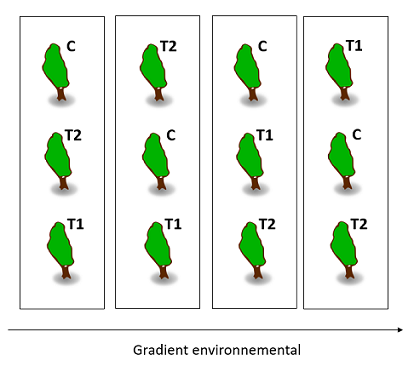Parameter estimation, sampling and experiment design
September 7, 2021
Objectives
Estimation
Estimate the mean and variance of a population from a sample.
Define the bias and standard error of an estimator.
Calculate the properties of an estimator by simulation.
Sampling methods
Describe the advantages and disadvantages of different sampling methods.
Choose a sampling method according to the characteristics of the population to be studied.
Experiment design
Know the important elements to consider when planning experiments.
Describe the principle and utility of a block experiment.
Statistics, parameters and estimators
At the last class, we saw a series of descriptive statistics: mean, variances, quantiles and others. In general, a statistic is a quantity calculated from observations of random variables.
A parameter is a characteristic of the population that is not directly measured. As we will see next week, these parameters are often part of a statistical model to describe the variation of a random variable.
In this class, our main goal will be to determine to which extent a statistic calculated from observations is a good estimator of a given parameter.
For example, if we measure the weight of red squirrels and calculate the mean (a statistic), what is our estimate of the mean weight of the red squirrel population (a parameter)? What is its margin of error?
In general, a parameter is a theoretical quantity. In our example, even if we could census all the squirrels, the weight of the individuals varies constantly and the composition of the population too (because of the births, deaths and migrations).
Parameter estimation
Estimation of the mean
Suppose we measure a variable \(x\) on a sample of \(n\) individuals randomly selected from a population, i.e. where each individual has the same probability of being included in the sample.
We use the sample mean:
\[\bar{x} = \frac{1}{n} \sum_{i = 1}^{n} x_i\] as the estimator of \(\mu\), the mean of \(x\) in the whole population.
Note: Following a common convention in statistics, parameters are represented by Greek letters and variables or statistics are represented with Latin letters.
One way to study the properties of an estimator is to simulate the sampling process from a known population.
For this example, imagine that the 1161 trees in the Kejimkujik dataset represent the entire population, and that we sample some of those trees.
kejim <- read.csv("../donnees/cours1_kejimkujik.csv")
dhp <- kejim$dhp
paste("The population has a mean DBH of", round(mean(dhp), 2), "cm with a standard deviation of", round(sd(dhp), 2), "cm.")## [1] "The population has a mean DBH of 21.76 cm with a standard deviation of 12.25 cm."In R, the sample function draws a random sample from the elements of a vector.
mean(sample(dhp, 20)) # mean DBH for a sample of n = 20 trees## [1] 20.86The replicate function repeats the same instruction a number of times; therefore we can easily generate multiple means from different possible random samples.
# the first argument for replicate gives the number of replications
replicate(5, mean(sample(dhp, 20))) ## [1] 19.5500 18.4800 20.3075 22.2800 24.4250The sample mean is therefore also a random variable. As we simulate more and more samples, the resulting values become more representative of the probability of obtaining different values of that mean.
The histograms below show the distributions (out of 10,000 replicates) of the mean DBH with a sample size \(n\) = 10, 20 or 40.

As the sample size increases, the distribution becomes less dispersed, but also more symmetrical. Next week, we will see that it approaches a normal distribution if \(n\) is large enough.
For a variable \(x\) that is distributed with a mean \(\mu\) and a variance \(\sigma^2\), we can prove that \(\bar{x}\) has a mean equal to \(\mu\) and a variance equal to \(\sigma^2 / n\). The standard deviation of \(\bar{x}\), which in this context is called the standard error, is therefore inversely proportional to the square root of \(n\).
Standard error of the mean: \[\sigma_{\bar{x}} = \frac{\sigma_{x}}{\sqrt{n}}\]
The mean and standard error of \(\bar{x}\) calculated from the 10,000 samples simulated above are consistent with the theoretical predictions.
| n | Mean (cm) | Standard error (cm) | \(\sigma / \sqrt{n}\) |
|---|---|---|---|
| 10 | 21.77 | 3.86 | 3.87 |
| 20 | 21.76 | 2.74 | 2.74 |
| 40 | 21.76 | 1.89 | 1.94 |
Since the mean of the estimator is equal to the value of the estimated parameter \(\mu\), \(\bar{x}\) is an unbiased estimator of \(\mu\).
Standard deviation or standard error
It is important not to confuse the standard deviation of \(x\) with the standard error of an estimator, such as \(\bar{x}\). The standard deviation of \(x\) measures the dispersion of the individual values of the variable relative to their mean. The standard error of \(\bar{x}\) measures the dispersion of the sample mean relative to the population mean. The standard error decreases with the size of the sample.
Since the standard error decreases according to \(\sqrt{n}\) rather than \(n\), if we want to reduce this standard error by half, we must increase the sample size by a factor of 4.

Note also that the standard error depends only on the size of the sample, not on the population size. This is true as long as the sample is small relative to the population. When sampling a significant fraction of the population (say more than 5%), the actual standard error is smaller than \(\sigma / \sqrt{n}\).
Estimation of the variance
To estimate the variance \(\sigma^2\) of a variable \(x\), one could calculate the variance of the sample with the equation seen at the last class.
\[s^2 = \frac{1}{n} \sum_{i = 1}^n \left( x_i - \bar{x} \right)^2 \]
Here, we \(s^2\) for the variance of a sample to differentiate from the population parameter \(\sigma^2\).
As before, we test this estimator by simulating 10,000 samples from the DBH vector with \(n\) = 10, 20, and 40. The following table shows the mean of \(s^2\) and its ratio to the popultion parameter \(\sigma^2\) (150.1 cm\(^2\)).
| n | Mean of \(s^2\) (cm\(^2\)) | Mean of \(s^2\) / \(\sigma^2\) |
|---|---|---|
| 10 | 136.3 | 0.90 |
| 20 | 143.1 | 0.95 |
| 40 | 146.6 | 0.97 |
This result shows that the calculated variance of the sample systematically underestimates the variance of the population. It is therefore a biased estimator. Why is this the case?
The problem is that the estimator \(s^2\) is not based on the population mean, but on its estimate \(\bar{x}\) calculated from the same sample. By definition, the sample is always centered on \(\bar{x}\), but \(\bar{x}\) is at some distance from \(\mu\). Therefore, the squared deviations from \(\mu\) are slightly larger than the deviations from \(\bar{x}\).
In fact, the estimator defined above underestimates the variance of the population by a ratio \((n-1)/n\), as shown in the last column of the table (0.9 = 9/10, 0.95 = 19/20). In that case, the bias can be corrected by multiplying the estimator by \(n / (n-1)\), giving the unbiased estimator:
\[s^2 = \frac{1}{n - 1} \sum_{i = 1}^n \left( x_i - \bar{x} \right)^2\]
Its square root provides an estimator for the population standard deviation:
\[s = \sqrt{\frac{1}{n - 1} \sum_{i = 1}^n \left( x_i - \bar{x} \right)^2}\]
Unlike \(s^2\), the \(s\) estimator for the standard deviation is biased, but it remains the most commonly used one, since there is no simple and unbiased formula for standard deviation.
Finally, we also use \(s\) as the \(\sigma\) estimator for calculating the standard error of \(\bar{x}\), so that standard error is estimated as \(s / \sqrt{n}\).
Degrees of freedom
Another way to explain the division by (\(n - 1\)) in the calculation of \(s^2\) is based on the concept of degrees of freedom.
The number of degrees of freedom is the number of independent data used in the calculation of a statistic. Here, \(s^2\) is computed from the deviations between each observation of \(x\) and its mean (\(x_i - \bar{x}\)). As we saw in the first class, the definition of \(\bar{x}\) ensures that the sum of these deviations is equal to 0. In this case, when we know the first \(n - 1\) deviations, we can automatically deduce the last, which is not an independent data point.
Bias and standard error of an estimator
The notions of bias and standard error were briefly presented in the previous section.
More generally, if we estimate a parameter \(\theta\) (e.g. \(\mu\)) with an estimator \(\hat{\theta}\) (e.g. \(\bar{x}\)), we can divide the mean square error between \(\hat {\theta}\) and \(\theta\) into two components. (In the equation below, the function \(E[]\) is another way of representing the mean.)
\[E[(\hat{\theta} - \theta)^2] = E[(\hat{\theta} - E[\hat{\theta}])^2] + (E[\hat{\theta}] - \theta)^2\]
This equation tells us that the mean square deviation between an estimator and the parameter is the sum of:
the mean square deviation between the estimator and its mean (that is, the variance of the estimator, or the square of its standard error);
the square of the difference between the mean of the estimator and the parameter (this difference is the bias);
So, we have the following relation: Mean square error = (Standard error)\(^2\) + (Bias)\(^2\).
These two sources of error have different properties. The standard error is due to the limited size of the sample and decreases as \(n\) increases. Bias is a systematic error that does not depend on the size of the sample, but may be due to a biased estimator or unrepresentative sampling of the population.
Exercise
In order to estimate the mean wood density of jack pine on a site, you first sample 9 trees, which have a mean wood density of 450 kg/m\(^3\) with a standard deviation of 90 kg/m\(^3\).
What is the standard error of this mean?
If you wanted to know the mean with a standard error of no more than 10 kg/m\(^3\), how many trees do you expect to sample?
Sampling methods
Sampling methods define criteria to obtain a sample that is representative of a population for the variable of interest.
Representativeness can be defined as an absence of bias: even if the distribution of values changes from one sample to another, on average, this distribution corresponds to that of the entire population.
In addition, we want an effective sampling method, that is, it allows us to estimate the desired parameters with the greatest precision for a given amount of resources (time, money).
Example
The chaga (Inonutus obliquus) is a fungal parasite of birch trees found in the boreal forest. Generally consumed as a herbal tea, it is particularly sought after for its high concentration of antioxidants which could provide health benefits.
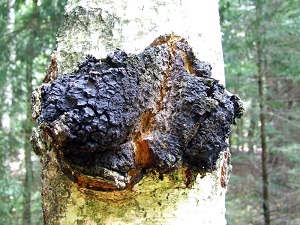
Imagine you were charged with creating a sampling plan to estimate the abundance of chaga and its commercial harvest potential in a 120 km\(^2\) (12 000 ha) region north-west of Rouyn-Noranda. How would you place your sampling units (plots) in that landscape? You have a map of forest types showing the distribution of stands identified by their dominant species.
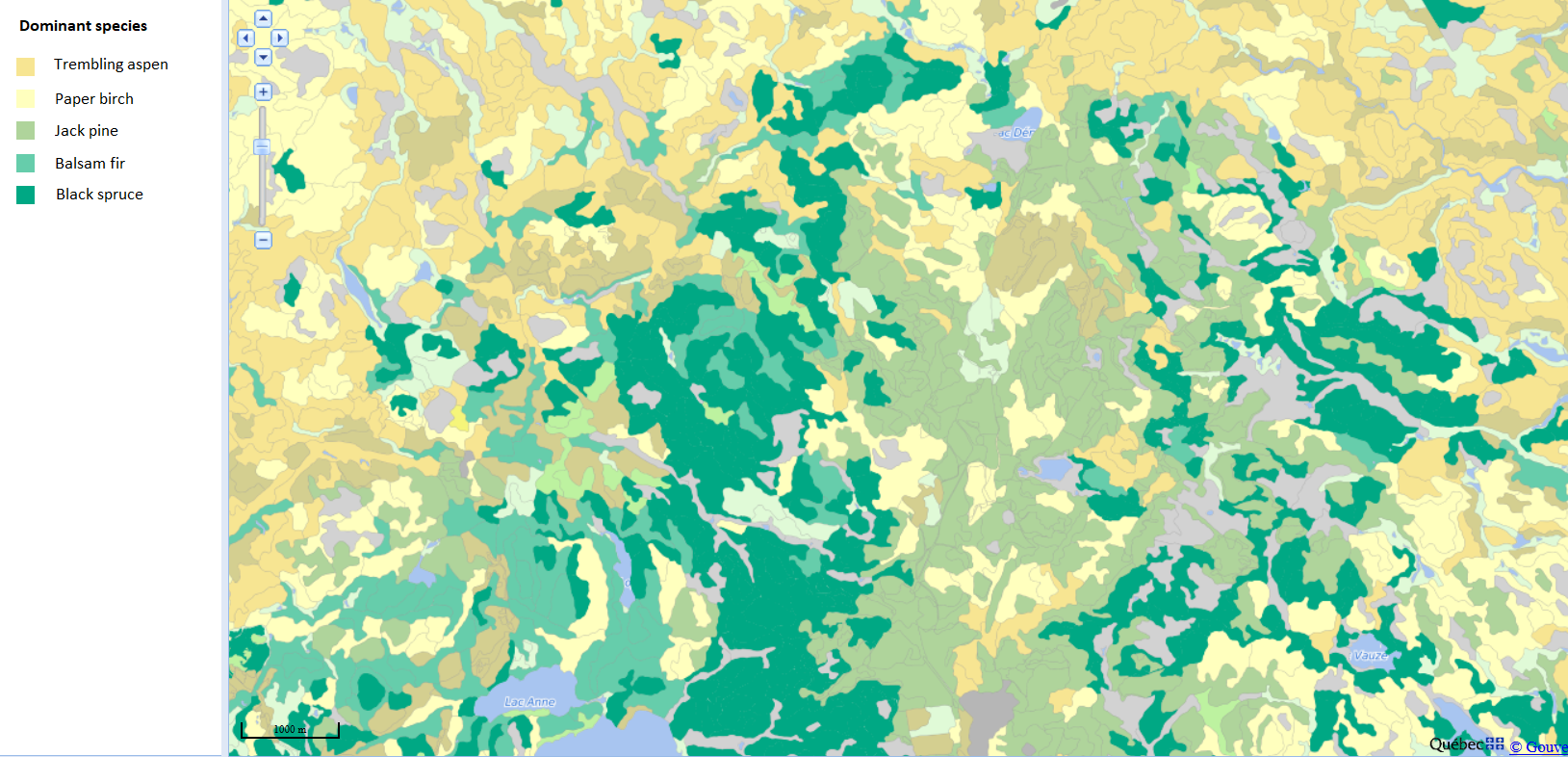
Simple random sampling
In simple random sampling, each individual or unit of observation has the same probability of being sampled.
For this type of sampling, the sample mean of the variable is an unbiased estimator of its population mean and its standard error is given by the formula seen above.
In our example, we select 20 random points in the study area to locate 50 m x 50 m plots (the sampling unit).

Advantages
This is the simplest method to obtain a representative sample.
It does not require any particular knowledge about the structure of the population.
Disadvantages
By chance, the points of a given sample may be concentrated in a certain part of the population.
As we will see, other methods may be more effective depending on the situation.
Stratified sampling
The population or study area is divided into strata, followed by simple random sampling in each stratum.
For example, instead of choosing to randomly place 20 plots in the study area, 4 could be placed in each of the 5 stand types.
This method is used when we believe that the measured variable varies more between individuals of different strata than between individuals of the same stratum.
Suppose we divide the population into \(m\) strata and calculate the mean of \(x\) for the random sample taken in each stratum. In this case, the estimator for the overall mean of \(x\) is a weighted mean of the means for each stratum.
\[\bar{x} = \sum_{j = 1}^{m} w_j \bar{x}_j\]
The standard error of that mean is given by:
\[s_{\bar{x}} = \sqrt{\sum_{j = 1}^{m} w_j^2 \frac{s_j^2}{n_j}}\]
In these equations, \(n_j\) is the number of observations in stratum \(j\), \(\bar{x}_j\) is their mean and \(s_j\) is their variance. Note that the fraction \(s_j^2 / n\) is the variance of the mean of stratum \(j\).
The weight \(w_j\) of a stratum is the fraction of the population or study area contained in that stratum. For example, if one quarter of the study area is in the first stratum, \(w_1\) = 0.25.
The more the values of \(x\) are homogeneous within each stratum and different between strata, the more efficient stratified sampling will be (greater precision of the mean) compared with simple random sampling for the same total \(n\).
However, this efficiency also depends on the choice of sample size in each stratum.
Each stratum can be sampled in proportion to its weight \(w_j\) in the population. If the variance is the same in each stratum, this choice maximizes the precision of the estimated mean.
If we know that the variable varies more in certain strata, we can oversample them relative to their weight \(w_j\).
If some strata are more difficult or expensive to sample, it may be necessary to undersample them relative to their weight.
If we are interested not only in the overall mean, but also in the mean of each stratum, we need a sufficient number of samples in each stratum, so the smallest strata will be oversampled compared to their weight \(w_j\).
Advantages of stratified sampling
More efficient estimation when the distribution of the measured variable differs significantly between strata.
With a sufficiently large sample, we obtain not only a good estimate of the overall mean, but also the mean of each stratum.
Disadvantages
This method requires some knowledge of the variation of the variable in the population in order to establish relevant strata.
The result may be biased if the weights used do not correspond to the actual proportions of each stratum in the population.
Systematic sampling
For this method, sampling points are taken at regular intervals in space, on a grid. It is important to choose randomly (as much as possible) the origin of the grid.
In our example, we choose a first random point in a 2 km x 2 km square northwest of the study area, then we place the subsequent points on a grid with 2 km between successive points.
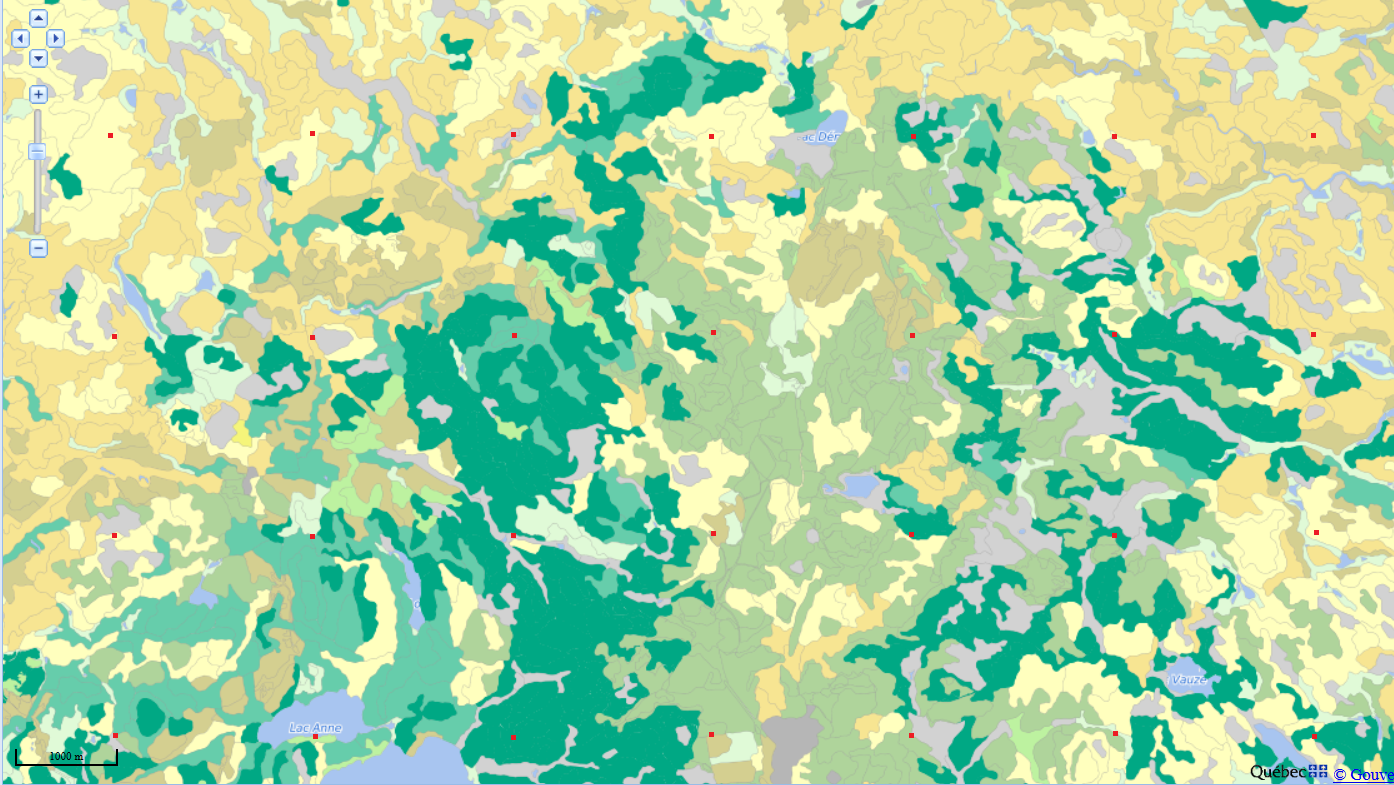
Imagine that the variable of interest is influenced by a spatial gradient, such as a gradual change in temperature, slope, or humidity across the study area. In this case, the values of \(x\) vary more between distant points than between close points. Thus, it is advantageous to spread out the points sufficiently in space, especially along the gradient, to obtain a representative sample of the entire study area.
The principle is similar to stratified sampling, where the points are distributed between strata so that each stratum is well represented. For systematic sampling, the points along the \(x\) and \(y\) axes are distributed so that all portions of the spatial gradient of the study area are well represented.
Advantages
- More efficient than simple random sampling if the variable is influenced by a spatial gradient.
Disadvantages
It is sometimes not practical to place points at regular intervals (e.g. irregularly shaped study area, inaccessible places).
If we want an estimate not only of the mean, but also of the variance of \(x\), then we have to repeat the systematic sampling with another grid (different random origin).
This situation is rare, but if the habitat varies periodically, this type of sampling may be unrepresentative. For example, with a series of hills and valleys, each point could fall into a valley; or in an agricultural landscape, successive points could always be in the middle of the field rather than at the edge.
Cluster and multistage sampling
For a large study area, transportation between sites can be time consuming and costly. In order to reduce costs while maintaining a random sampling of plots, we can use cluster or multistage sampling.
In this method, the population or study area is divided into clusters. We first randomly choose a number of clusters. Then, we can sample all the individuals from the chosen clusters, or more frequently, take a random sample from each chosen cluster (multistage sampling).
In our example, we divide the study area into clusters of 500 x 500 m and choose six of them at random. Then we randomly select five 50 x 50 m plots in each of the selected clusters (total of 30 plots).
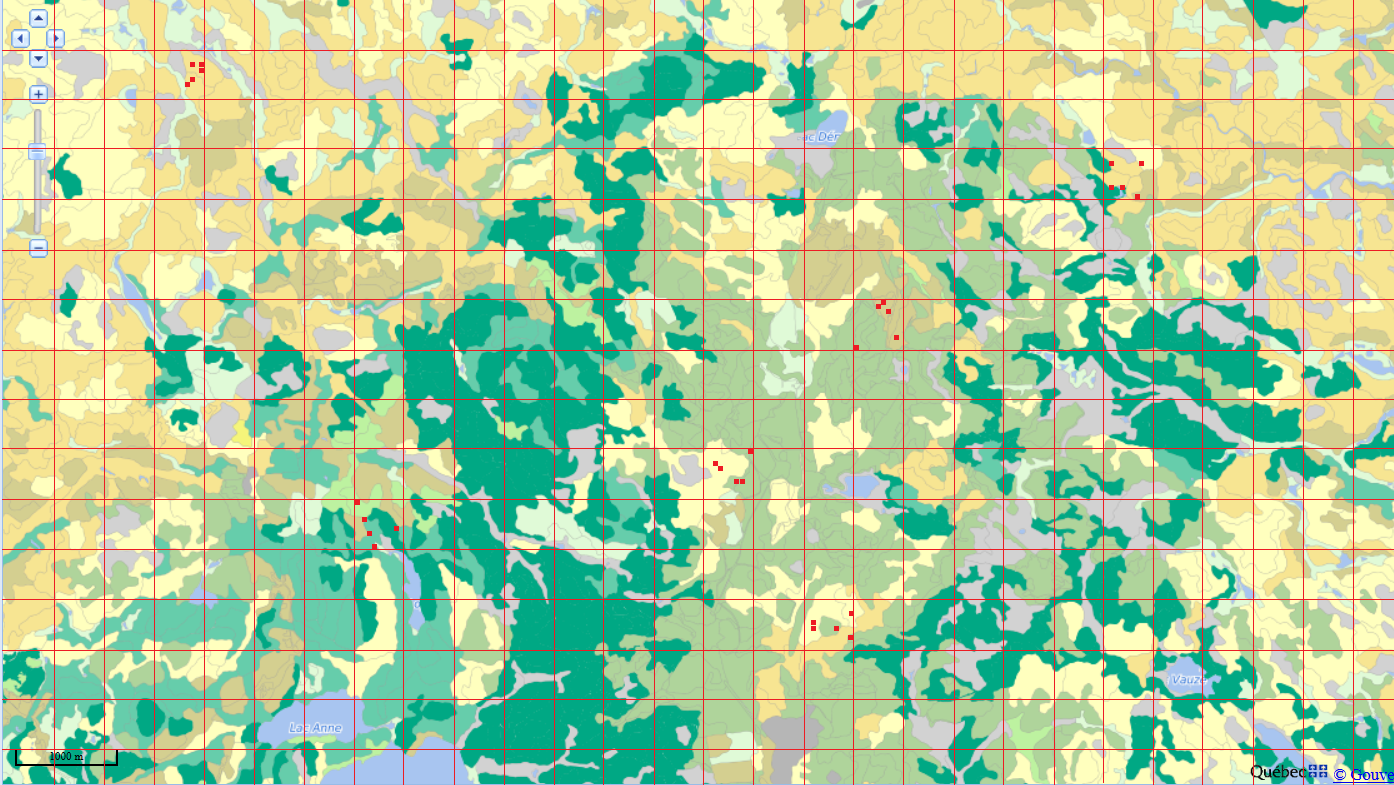
By reducing the costs and time associated with moving between observation units, this method allows in principle to sample more individuals for the same number of resources.
While \(x\) varies a lot within clusters but has a similar distribution from cluster to cluster, the efficiency of this method approaches that of simple random sampling. However, as we saw earlier, two points close together often have more homogeneous characteristics than two distant points. In this case, cluster (or multistage) sampling is less efficient than other methods.
Advantages
- Reduces the costs associated with sampling, allowing us to increase the sample size for a given budget.
Disadvantages
- Less efficient sampling (less precise estimate) if the study area is heterogeneous. This disadvantage may be partially offset by the increase of \(n\).
Adaptive sampling
If we want to sample a rare species, the methods seen previously may be ineffective due to the absence of the species in most randomly selected plots.
In this case, adaptive cluster sampling can be used. A number of independent plots are first sampled, but when the desired species is detected, sampling is continued with plots adjacent to the one where the species was detected.
Since sampling is concentrated in areas where the species is abundant, a statistical correction must be applied to properly estimate abundance in the entire study area. I have included some articles in the references section for more information on this method.
Smith, D.R., Brown, J.A. and Lo, N.C.H. (2004) Application of Adaptive Sampling to Biological Populations, in Thompson, W.L. (ed.) Sampling Rare and Elusive Species. Island Press, Washington. pp. 75-122.
Talvitie, M., Leino, O. and Holopainen, M. (2006) Inventory of Sparse Forest Populations Using Adaptive Cluster Sampling. Silva Fennica 40, 101-108.
Other sampling methods
In this class, we have seen some general sampling strategies. Other methods exist to meet the need for specific fields of study.
For example, in animal ecology, individuals are mobile and often difficult to detect. Methods such as site occupancy estimation and capture-mark-recapture have been developed to account for the inability to detect all individuals in a single visit to a site.
Experiment design
While it is not always possible to manipulate the variables of a system in a controlled experiment, it remains the surest way to isolate a cause-and-effect relationship between two variables.
For example, suppose we want to determine the effect of temperature on the growth of black spruce seedlings. We could measure seedling growth along a north-south temperature gradient. However, other important variables will also change along this gradient, including the length of the day. If we try rather to measure the growth of seedlings of the same population in warmer and colder years, our results would be influenced by other variables, such as precipitation, which also vary from year to year.
Thus, experimental manipulation aims to eliminate the effect of other variables that might be confounded with the effect we want to measure.
In this example, a possible experiment would be to grow seedlings from the same population in temperature-controlled chambers, keeping the other variables constant (e.g. light, moisture, soil type). To manipulate the temperature of the air, it is necessary here to create an artificial environment, but other types of experiments can be carried out in a natural environment, as we will see in the next examples.
Exercise
After changing the composition of fertilizer applied to several corn fields in one region, agronomists note that the average yield is significantly higher than last year in the same fields. Do these results convince you that the new fertilizer is superior?
To compare the effect of two soil preparation methods on forest regeneration after logging, you measure average seedling growth in two logging areas, one where method 1 was applied and the other where method 2 was applied. Is it useful to delimit several plots on each area to increase the size of your sample?
Principles of experiment design
In this section, a treatment is an experimental manipulation, for which we want to measure the effect on a response variable. Different treatment options or treatment intensities can be tested in the same experiment (for example, the effect of several soil types, or different soil moisture levels, on growth).
In biology, it is expected that individuals will respond differently to a treatment. Thus, we are generally interested in estimating the average effect of a treatment from the responses measured on a group of individuals. Today, we focus on general principles of experiment design. In the next few weeks, we will discuss statistical methods to estimate the effect of treatments.
The main objective of experiment design is to isolate the effect of interest while controlling for other sources of variation. Here are some useful principles in line with this main objective.
Control group
To ensure that the treatment is the cause of the response observed in the treated individuals, it is necessary to compare this response to that of an untreated control group, placed under the same environmental conditions. Sometimes it is necessary to establish more than one control group.
For example, suppose we want to measure the effect of a herbivore insect on seedling growth and survival in a forest environment. To do this, we cover some of the seedlings with a mesh net small enough to exclude the desired insect. In this case, the treatment is the exclusion of the insect. However, to verify that the net does not itself have an effect on the measured response, two control groups could be defined: one without a net, and the other with a mesh net slightly larger than the insect.
The state of a system before the treatment is rarely a good control, as we saw in part (a) of the exercise above, because the system is affected by other variables that change from one period to the other. If you want to compare a site before and after a treatment, it is better to follow a control site during the same period. This type of plan is known by the acronym BACI ( before-after-control-impact) and is used in particular for studies of the impact of anthropogenic disturbances on ecosystems. In this case, a change in time observed on the disturbed site, but not on the control site, constitutes a better proof of impact.
When treatments serve to compare the effect of different levels of a variable (eg low, medium or high pH), the concept of a control does not apply.
In the following test, we consider the absence of treatment as a treatment; for example, the expression “each treatment” also includes the control.
Random assignment
Simple random sampling, as we saw earlier, gives each individual the same probability of being part of the sample.
In an experimental setting, the random assignment of different treatments (including the absence of treatment) gives each individual the same chance of getting one or the other treatment. As with random sampling, the goal is to eliminate sources of bias.
Ideally, the only source of systematic difference between the two groups should be the treatment applied. If another factor consistently varied between the control and treated groups, the effect of this factor would be confounded with that of the treatment.
In a context of random assignment, it is possible to obtain by chance an association between the treatment and another characteristic of the population; this probability is greater when the sample size is small. Block design (see below) is one way to address this problem for a limited number of confounding factors.
Replication
In principle, random assignment makes it possible to estimate without bias the effect of a treatment for the population where the experiment is carried out. However, in order to check whether the effect is generalized to several sites, it is useful to create several replicates of the experimental design.
If the replicates of a treatment are more similar to each other than those of the other treatments, they cannot be considered independent observations. In ecology, this type of pseudoreplication is often due to a proximity of sites in space. For example, in part (b) of the previous exercise, the delineation of several plots on the control site and the treated site does not constitute an independent replication.
Blocking
Random assignment of treatments is intended to ensure that individuals receiving one treatment or another have, on average, similar characteristics. With a large enough sample, we can control the effect of other variables affecting the response, without even knowing what these variables are.
We may also be known in advance that certain characteristics of individuals could influence their response to treatment. In this case, it is better to group the individuals into more homogeneous blocks and randomly assign the various treatments within each block.
For an experiment with a single treatment and a control group, pairs of similar individuals may constitute a block. For example, suppose we want to test the effectiveness of a chemical compound to prevent defoliation of trembling aspen by forest tent caterpillar. In this species, each tree can give birth to several clones. In this case, we can choose pairs of clones and for each pair, apply the treatment to one of the two clones chosen at random. Thus, we eliminate genetic variation as a source of difference that can be confused with the effect of treatment.
Randomized complete block designs
In a randomized complete block design, individuals are divided into blocks and each of the treatments is randomly assigned to an equal number of individuals per block.
Example: We plant maples from different populations in a single plot and want to measure the effect of a change in soil pH on their productivity. We apply three treatments: + pH (T1), - pH (T2), and control (C). Trees in the same population are closer genetically and can share particular adaptations. We therefore define blocks for each original population and randomly assign 1/3 of the individuals in each block to C, 1/3 to T1 and 1/3 to T2, as shown in the following diagram. (For simplicity, only 3 trees are shown by population.)
As mentioned in the replication section, environmental conditions are generally more similar for two points closer together than two points farther apart. In this case, to avoid confounding local environmental conditions with the effect of a treatment, it is advantageous to disperse the treatments in space, especially if there is a known environmental gradient (slope, proximity to water, etc.). In the diagram below, the trees are organized in blocks along the gradient axis.
When the blocks are organized according to a spatial gradient, the individuals in the same block must be close together so that the environmental conditions are homogeneous, but not so close that the treatments “contaminate” adjacent individuals.
We will learn how to analyze data from blocked experimental designs in the class on analysis of variance (ANOVA).
Summary
An estimator is biased when its mean over all possible samples differs from the value of the parameter to be estimated.
The standard error measures the dispersion of an estimator from one sample to another, and decreases with the size of the sample.
In addition to simple random sampling, there are other techniques that may be more effective depending on the structure of the population / study area:
stratified sampling when groups (strata) can be defined where the variable being measured varies greatly from one group to another;
systematic sampling when there is a spatial gradient that affects the variable being measured;
cluster or multi-stage sampling when it is more practical to sample clusters of individuals in different locations;
adaptive sampling to estimate the abundance of a rare species.
When designing an experiment, it is important to randomly assign treatments to the different experimental units (e.g. individuals or sites). It can be advantageous to group similar units into blocks so that all treatments are represented in each block (with random assignment within the blocks).

